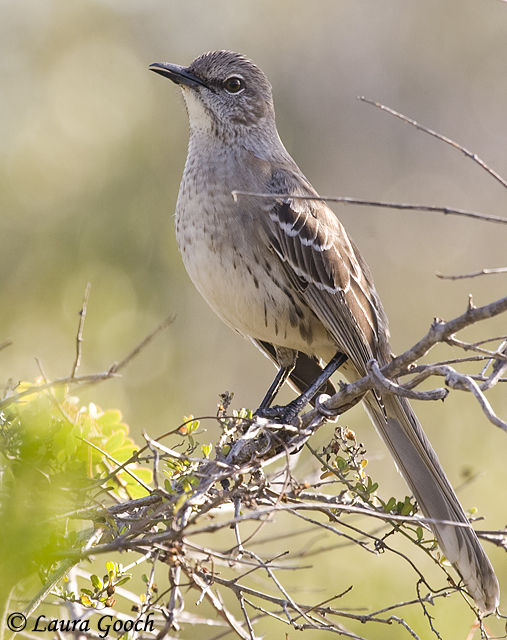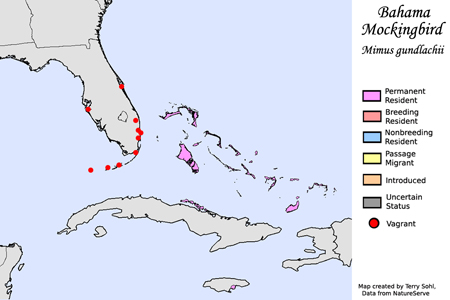| Length: 11 inches | Wingspan: 14.5 inches | Seasonality: Non-resident in South Dakota |
| ID Keys: Gray overall, lighter below, obvious dark streaks on flanks, pale streaks on upper back, thin dark throat stripe, white chin | ||
 The
Bahama Mockingbird is a relative of North America's much more common
Northern Mockingbird. They
are found on islands in the Bahamas, and in other scattered locations in the
western Caribbean. In the United States, they are vagrants to Florida.
The first sighting was in the Dry Tortugas islands off the Florida Keys in
1973, but a number of sightings have occurred since then. While
somewhat similar to the Northern Mockingbird in overall structure, the
Bahama Mockingbird can easily be distinguished from it's more common North
American relative by the streaking on its flanks, the larger size, the dark
throat stripe, and less "clean" appearance on the face and head.
The
Bahama Mockingbird is a relative of North America's much more common
Northern Mockingbird. They
are found on islands in the Bahamas, and in other scattered locations in the
western Caribbean. In the United States, they are vagrants to Florida.
The first sighting was in the Dry Tortugas islands off the Florida Keys in
1973, but a number of sightings have occurred since then. While
somewhat similar to the Northern Mockingbird in overall structure, the
Bahama Mockingbird can easily be distinguished from it's more common North
American relative by the streaking on its flanks, the larger size, the dark
throat stripe, and less "clean" appearance on the face and head.
Habitat: Found in shrubby areas with scattered trees.
Diet: Feeds on insects, fruits, and berries.
Behavior: Prefers areas of thick shrubs, and is more secretive and less visible than it's sometimes bold relative, the Northern Mockingbird.
Nesting: Nesting behavior is poorly understood, but it is believed the female lays 2 or 3 eggs, and that nesting pairs raise more than one brood per season.
Interactive eBird Map: Click to access an interactive eBird map of Bahama Mockingbird sightings
Song: The song of a Bahama Mockingbird is a series of repeated, mostly two-syllable phrases.
Migration: Considered a permanent resident throughout its range, although some birds obviously wander, given the sightings in Florida.
Feeders: May attend feeders for fruit
Similar Species: Similar in structure to the Northern Mockingbird, but differences are obvious if seen well.
Conservation Status: Populations are not very large and they aren't found over a very wide geographic region, but there are no serious conservation concerns at this time. The Bahama Mockingbird is considered a species of "Least Concern" by the IUCN.
Further Information: 1) Florida Fish and Wildlife Conservation Commission - Bahama Mockingbird
2) WhatBird - Bahama Mockingbird
3) Birdlife International - Bahama Mockingbird
Photo Information: Photo taken by Laura Gooch - Photo licensed under Creative Commons Attribution NonCommercial ShareAlike 2.0 Generic License.
| Click below for a higher-resolution map |
 |
| South Dakota Status: Non-resident in South Dakota |
Additional Bahama Mockingbird Photos (coming soon!!)
